Abstract
Physical therapy intervention along with nutritional rehabilitation has recently become an inevitable combo after recent evidences suggesting a strong interaction between malnutrition and neuro-muscular disabilities which contribute to a significant burden in global settings. Recent studies confirm that appropriate physical assessment of neuro-musculo skeletal system, developmental assessment or cognitive tools along with nutritional assessments followed by exercise rehabilitation will yield positive results in children with malnutrition. There is an obvious need to make available a simple physical therapy exercise guidelines with simple measure and exercise to be used in resource limited settings of developing countries. The purpose of this clinical commentary is to summarize simple assessment tools to evaluate activity impairment, participation restriction, gross motor activity and simple physical therapy intervention program for children with disability secondary to malnutrition.
Keywords: Malnutrition, Physical therapy, Exercise, Play therapy
INTRODUCTION
The prevalence of malnutrition is continuously decreased, however it still remains as a major cause of preventable morbidity and mortality among the young children in many developing countries, especially in African continent. About 50% of all deaths among children aged less than 5 yr can be traced back to under nourishment (Prentice et al., 2016). In most parts of the world malnutrition divulges in the form of undernourishment, which is caused by diet lacking in adequate calories and protein. Child under nourishment is a critical problem in Africa and elsewhere (Harttgen et al., 2013). For instance, poor nutritional status has been a serious problem in Ethiopia for many years and till recent only 4% of children aged between 6–23 months are fed appropriately based on recommended infant and young child feeding. There is also delay in introduction of complementary food to the children (Disha et al., 2012).
For children under 59 months the world wide prevalence are 25%, 8%, and 15% for stunted, wasted and/or underweight respectively. Children in the least developed countries are even more at risk and numbers increase up to 37%, 9%, and 22% for stunting, wasting and underweight respectively (Requejo et al., 2015). Among the overall children in Ethiopia aged between 6–9 months, only half of them receive complementary food. These negative effects are carried into the adult population in this country, where 27% women aged 15–49 yr are thin, with body mass index below 18.5 kg/m2 and 9% are moderately or severely thin. This in turn would lead to more birth of malnourished children. A recent Index Mundi fact sheets indicates that Ethiopia is one of the countries with abundant malnourished children. Moderate-to-severe malnutrition during infancy is associated with a significantly elevated incidence of impaired intelligent quotient (IQ) in adulthood, even when physical growth is completely rehabilitated (Berhan and Berhan, 2014).
But it is worth mentioning that in 2013, Ethiopia achieved the child survival millennium developmental goal by reducing deaths among under-5-yr-olds by two-thirds. So, now it is the appropriate time to focus on curbing physical and neuro-disabilities among malnourished children.
NEED FOR PHYSICAL THERAPY INTERVENTIONS
Incidence of early childhood malnutrition or under nutrition may lead long-term effects like impairment of gross and fine motor skills, easy fatigue, loss of flexibility, impaired rapid sequence movements, behavioural problems, and cognitive impairment like lower attention spans, language impairment, learning disabilities, low IQ scores (Waber et al., 2014). These effects are most likely to be continued into adulthood (Galler et al., 2012). Hence, clinical judgements and rehabilitation program limited to identifying nutritional risk and nutritional supplementations are inadequate in addressing developmental skill of children.
SCOPE AND NEED FOR THIS GUIDELINES
There are ample documentation reporting interplay between neuro-physical disabling conditions and malnutrition. Many studies have reported the effect of malnutrition on growth, cognition, mental and systemic development in children with malnutrition. Literatures even suggest that if malnutrition occurs in the vulnerable period of brain development, it can result in motor impairment (Andrew and Sullivan, 2010; Grantham-McGregor et al., 2007; Kuperminc and Stevenson, 2008). In Africa, however clinical application of assessments of children with physical and neuro-disabilities is seldom practised. In addition evaluating the impact of infantile malnutrition on development in developing countries is inevitably complicated by social context. It is of paramount importance that clinicians in developing countries soon realise that early detection of motor impairments in malnutrition children, followed by early physical rehabilitation will help prevent, minimize and effectively treat physical impairments and motor delay.
A recent audit conducted at Gondar University Hospital, Ethiopia where 362 children were admitted in pediatric ward for severe malnutrition and then referred to physical therapy department for treatment for impairments of which 82.1% were <5 yr old. These children were intervened by developmental stimulation (play therapy), the results showed improvement in self-care domain, mobility domain and aggregate outcomes of the pediatric evaluation of disability inventory (PEDI) score (Gordon et al., 2013). With scarcity of expertise in physical rehabilitation and trained community based rehabilitation (CBR) workers along with resource limiting settings in developing countries, it is vital that the clinicians understand the scope and requirement of clinical physical rehabilitation practice guidelines to screen, refer, and treat malnourished children (Table 1).
Table 1.
Key points
| Findings |
| The absence of agreed and evidence based guidelines for physical therapy interventions in developing countries for malnutrition children, timely physical therapy intervention are not yet incorporated into routine of pediatric care in hospitals of developing countries. |
| It is very important to establish an appropriate clinical practice guideline for physical rehabilitation based on setting resources. |
|
|
| What is added? |
| Simple, reliable assessments on participation and activity level of malnutrition children. |
| Physiotherapy interventions based on the phase. |
|
|
| Implications |
| Evidence based at the same time simple and cost effective assessment, referral inputs and physical therapy treatment protocols can be more beneficial and easy to implement in resource limited pediatric care settings. |
Despite the fact there are encouraging clinical outcomes and development of exercise rehabilitation protocols, a tailored exercise rehabilitation guideline for malnourished children in developing countries is notably lacking. At present, physical rehabilitation practice protocols for malnourished children appears to be based on early evidences and conceptions.
DRAFTING OF CLINICAL PRACTICE GUIDELINES
This article reviews the best available evidence-based literature pertaining to assessment and rehabilitation of malnutrition children. In particular the World Health Organization (WHO) homepage, The Ethiopian statistic agency, and a local internal survey audit done at University of Gondar Hospital were also used (De Onis and Weise Prinzo, 2014; Laillou et al., 2014). Using this information in combination with the interdisciplinary expert opinion including present authors, we present a physical rehabilitation protocol for malnutrition children in resource limited setting of developing countries.
RISK FACTORS, PROGNOSTIC INDICATORS, AND ADVERSE COMPLICATIONS
In low income countries particularly in Ethiopia, children are exposed to multiple risk factors including poverty, maternal depression, poor women education, poor socio economic environment, lower preceding birth intervals, scarcity of health care personnel, low birth weights, underweight mothers, and poor ante natal care (Table 2). Multiple factors which may determine the outcome of a child with malnutrition are; birth weight (normal, 2.5–4 kg), period of breast feeding (normal, ≥6 months), absence of infection, early medical interventions, care giver factors, effectiveness of nutritional programs and quality of life (Campos et al., 2016; Puett and Guerrero, 2015).
Table 2.
Adverse complications associated with malnutrition
| Increased mortality |
| Weight loss and sarcopenia |
| Impaired immunity and susceptible to infections |
| Decreased physical ability |
| Decreased mental ability |
| Developmental delay |
| Poor quality of life |
| Lower intelligent quotient and stunted growth |
| Risk of social isolation |
| Falls, hospital stay |
Recently, physical activity appears to be an earlier indicator for successful rehabilitation than weight gain. Crookston et al. (2010) observed that children who recovered from stunting in infancy were likely to experience catch-up growth and show no differences in development compared to healthy children (Pulakka et al., 2015).
ASSESSMENT OF CHILDREN WITH MALNUTRITION
A well integrated holistic assessment which includes medico-nutritional plans of management or advice along with physical therapy intervention plans is most likely to improve outcomes (Gladstone et al., 2014; Trehan and Manary, 2015). Very little is known about parenting practices in Ethiopia, most studies report low level of education and unawareness among mother in many African countries. Many researchers reported maternal-child interaction as an important factor in childhood malnutrition and also recommend Socio Emotional Development Scale as a suitable assessment tool for African settings (Cooper et al., 2009; Stewart et al., 2011).
Subjective assessments are important domain in guiding the physical examination and anthropometric measurements. Tools like subjective global assessment (SGA), mini nutritional assessment, and subjective global nutritional assessment (SGNA) score for children can be used (Secker and Jeejeebhoy, 2012; Steenson et al., 2013). The SGNA is a simple pediatric nutritional risk score; consisted of nutrition oriented physical examination and information on the child’s recent and current height and weight, parental heights. The SGA tool consisted of features identifying nutritional risks, gastrointestinal symptoms, functional capacity, and physical examination like loss of subcutaneous fat, muscle wasting, ankle edema, sacral edema, and ascites. From a clinical point of view, these tools allow a quick and valid assessment suitable for practice.
With recent evidences reporting association between neuro developmental delay, neuro disabilities and malnutrition (Gladstone et al., 2014). Programs to improve malnutrition will be most effective if they also target the neurodevelopment of children. Depending on the type of malnutrition brain is affected in different ways; for example chronic malnutrition (stunting is manifested as low height for age), acute malnutrition (formerly known as protein-energy malnutrition and manifested as either kwashiorkor or wasting, low middle-upper arm circumference [MUAC] or low weight for height), or a specific micronutrient deficiency such as iron or zinc. Some deficiencies, such as chronic malnutrition, will affect global functioning of the brain and are assessed best through general developmental assessment tools (Aly and Taj, 2010; de Moura et al., 2010).
The quality of stimulation at home can be better measured by the modified version of the Infant/Toddler HOME (Home Observation for Measurement of the Environment) inventory developed by Bangladeshi scholars suitable for many low resource settings. The modified version of inventory contains 60 items and six subscales: (a) organisation of the physical and temporal environment, (b) stimulation (opportunities for variations in daily stimulation at home), (c) maternal involvement with the child, (d) play materials, (e) avoidance of restriction and punishment, and (f) Emotional and verbal responsivity of the mother. The total score was calculated by summing up all positive responses (Nahar et al., 2012).
Other deficiencies such as iron deficiency may have more effect on neural myelination and tools to assess processing speeds may be more useful. A neurologic examination should include assessment of tone, cranial nerve problems (particularly swallowing difficulties), head circumference, and dysmorphic features to help in understanding any underlying etiology for the child’s condition.
ASSESSMENT OF PARTICIPATION AND ACTIVITY LEVEL
PEDI is a comprehensive validated tool in the assessment of key functional capabilities and performance of children aged 6–90 months (0.5–7.5 yr). It assesses the functional ability in three domains; self-care, mobility and social functioning of the child. PEDI is an easy and quick way assessment tool of children abilities with scoring of 0 or 1. Moreover, PEDI is more adaptable and easily translatable to the context of cultures (Dumas et al., 2015).
A child with malnutrition can show delayed gross motor function as one of the associated problems. Motor development can be assessed using various tools like the Bayleys scale, the Denver II scale, the Peabody scale, Alberta Infant Motor Scale (AIMS), the Movement Assessment of Infants, the Test of Infant Motor Performance, Gross Motor Function Measure, Differential Ability Scales-II, etc., AIMS, based on neuro maturation concept and dynamic theory, is a quick observational assessment tool used to evaluate the motor development in infants between the ages of 0 to 18 months. It is comprises of 58 items observed in four different positions (i.e., prone, supine, sitting, and standing). It is a reliable (r=0.85 to 0.97) and valid (sensitivity, 80%; specificity, 90%; positive predictive value, 70%; and negative predictive value, 80%) tool. AIMS is a useful tool in assessing the six child growth standards set by the WHO. These include sitting without support, hands-and-knees crawling, standing with assistance, walking with assistance, standing alone, walking alone. According to the scores of AIMS, a percentile rank below 10 is considered to be atypical performance, between 11–25 is considered as suspected performance, between 26–75 is normal, 76–90 is very good performance and between 90–100 is excellent performance (Iyer et al., 2003; Maia et al., 2011).
It is important to remember that the severity of children motor disability is usually associated with feeding difficulties. Physical therapy evaluations shall include ability to sit, ability to use of assistive devices and positioning in severe children. Gross Motor Functioning Classification System (Fig. 1) which is a broad 5-category system for defining motor functional limitations and abilities can be an easy useful adjunct tool in this context (Gladstone et al., 2014; Hiratuka et al., 2010).
Fig. 1.
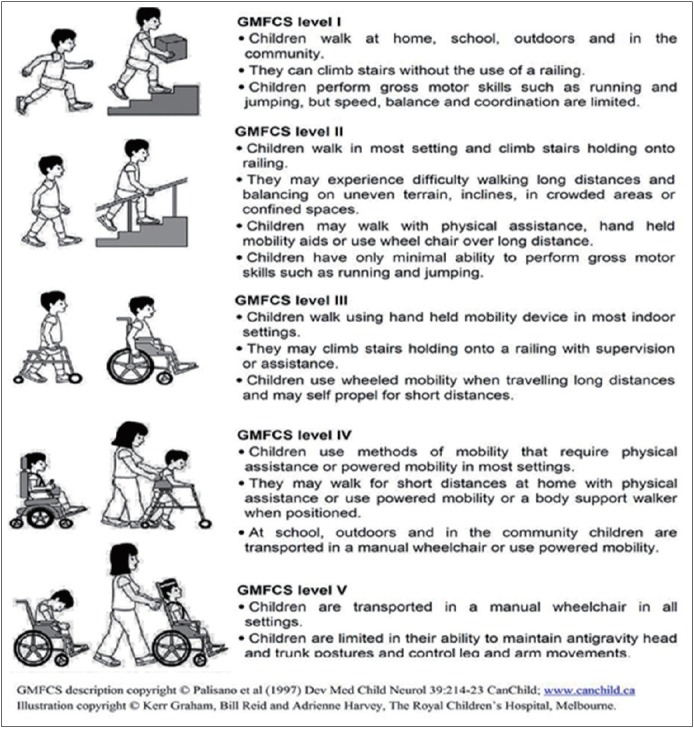
Gross Motor Functioning Classification System (GMFCS) descriptors and illustrations for children between their 6th and 12th birthday.
ASSESSMENT BASED ON BODY FUNCTIONS AND STRUCTURE LEVEL
Through observation will be one of the key components in the assessment of malnourished children. Among the two specific kinds of malnutrition that is marasmus (severe wasting) and kwashiorkor (Oedematous). In marasmus signs such as prominent bones (rib rosaries), skinny limbs, loose skin especially in the buttock region (buggy pants) can be noticed. In kwashiorkor bilateral pedal edema, hair color changes, dermatosis and protuberant belly are seen. Other signs to look for during the general examinations are depigmentation, hyperpigmentation of skin, general pallor, kolionychia in iron deficiency. Measuring the MUAC using tape is a quick and simple way to determine whether or not a child is malnourished using a standard colored plastic strip. MUAC is suitable to use in children from the age of 12 months up to the age of 59 months. However, it can also be used for children as young as 6 months with length above 65 cm. Even head circumference measure may imply an under lying neuro diagnosis (Goossens et al., 2012).
The locomotor system examination will surely help gauze the motor disability of the child. Children should be assessed for muscle wastings, decreased muscle strength, child’s tone which can sometimes be stiff or floppy differentiation of which would aid in positioning splinting eventually good feeding. In presence of bipedal pitting edema grade them; grade 1 edema (only feet), grade 2 (up to knee), and grade 3 (above knee). Mobility of the joint should be examined for hypo and hypermobilities using range of motion measuring tools like goniometer (Laillou et al., 2014).
PHYSICAL THERAPY INTERVENTIONS FOR MALNUTRITION CHILDREN
The routine care or medical managements for malnutrition is well established and discussed enough in many studies. A cheerful environment which is stimulating, structured play therapy, progressively increasing physical activity, and mother’s involvement in care of the child are important components of therapy. Low cost and culturally appropriate homemade toys, lent toys, picture books, parental education to make mothers more effective in teaching their children and enhancing maternal child interactions; mothers responsiveness to their infants and playing, chatting, singing, showing love and incorporating playing in daily activities such as bathing, dressing and feeding to improve development. It is important to advice mothers to avoid physical punishments.
Physical therapy intervention in malnutrition children holds paramount importance, if we are to reduce neuro-musculoskeletal and developmental disabilities. Physical interventions ideally should begin after the child medical conditions are stable. The aims of physical activity or play therapy are mentioned in Table 3. The WHO structured play therapy sessions will address these aims to physically treat malnutrition children (Appendix 1).
Table 3.
Aims of physical activities in malnutrition children
| To stimulate the child in physical activity as soon as the child is physically stable. |
| To structure play therapy maternal involvement and education (e.g., comforting, feeding, bathing, playing). |
| To create a stimulating environment. |
Appendix 1.
Structured play activities (World Health Organization)
| Play therapy is intended to develop language skills and motor activities aided by simple toys. It should take place in a loving, relaxed and stimulating environment. |
| Language skills At each play session:
|
| Motor activities Encourage the child to perform the next motor milestone, e.g.:
|
|
Activities with toys Simple toys made from readily available materials, can be used to encourage variety of different motor activities: |
‘Ring on a string’
|
‘Rattle and drum’
|
|
‘In and Out’ toy with blocks Let the child explore blocks and container. Put blocks into container and shake it, then teach the child to take them out, one at a time, saying ‘out’ and ‘give me’
|
Make a game of it
|
Posting bottle
|
Stacking bottle tops
|
Books
|
Doll
|
In practice and implementations of early stimulation program (Appendix 2) the family will hold the highest ‘responsibilities, so as the child will have more time of stimulation and achieve the aim of the treatment. The role of CBR in parental education and helping the parents to insure the continuity of the stimulation therapy will be crucial in low income countries. Some of the areas of stimulation include; movement, body control, strength, balance, use of the hands, the senses, communication, interaction with other people, basic activities for daily living, observing, thinking, and doing.
Appendix 2.
Early stimulation and development activities
Activities to help the child lift and control her head (and use her eyes and ears)
|
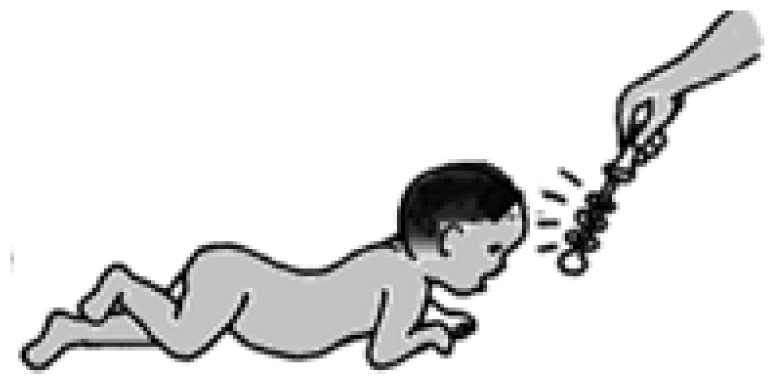
|
Activities to encourage rolling and twisting
|
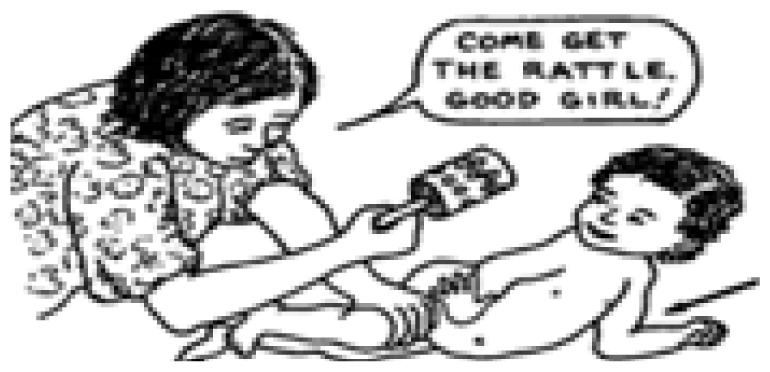
|
Activities to help develop gripping, reaching, and hand-eye coordination
|
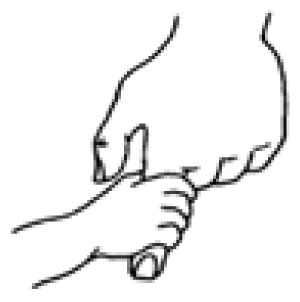
|
Activities to improve body control, balance, and sitting
|
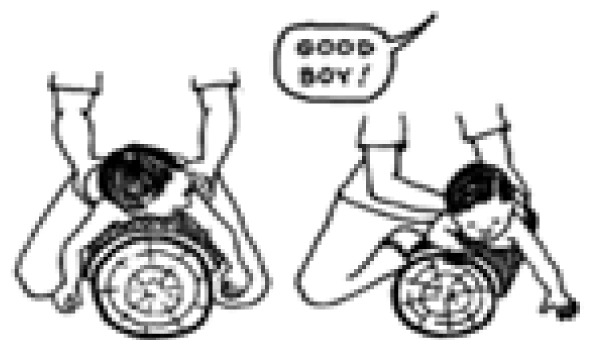
|
Activities to encourage creeping and crawling
|
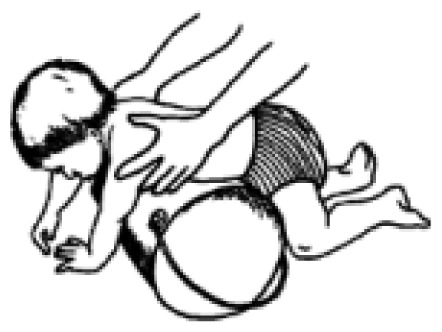
|
Activities for standing, walking, and balance
|
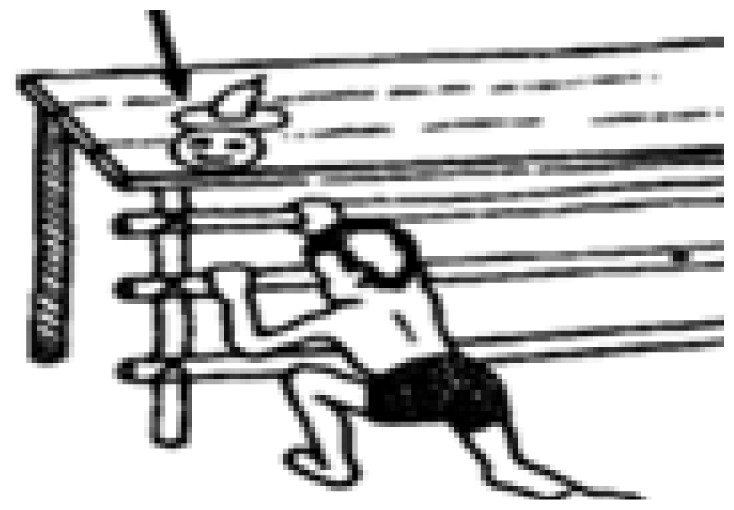
|
Pictures courtesy: David Werner, Disabled Village Children.
CONCLUSIONS
Physical activity and exercise prescription in line with neuro motor disabilities and health profile of the malnutrition children is seldom practiced in resource limited settings. Instead, it is advised to initiate early exercises and physical therapy interventions in malnutrition children with tools made of simple available materials to encourage stimulation and play. In addition community based parental education and play activities with food supplementations should be initiated.
Footnotes
CONFLICT OF INTEREST
No potential conflict of interest relevant to this article was reported.
REFERENCES
- Aly Z, Taj F, Ibrahim S. Missed opportunities in surveillance and screening systems to detect developmental delay: a developing country perspective. Brain Dev. 2010;32:90–97. doi: 10.1016/j.braindev.2009.06.004. [DOI] [PubMed] [Google Scholar]
- Andrew MJ, Sullivan PB. Feeding difficulties in disabled children. Paediatr Child Health. 2010;20:321–326. [Google Scholar]
- Berhan Y, Berhan A. Reasons for persistently high maternal and perinatal mortalities in Ethiopia: Part II-Socio-economic and cultural factors. Ethiop J Health Sci. 2014;24(Suppl):119–136. doi: 10.4314/ejhs.v24i0.11s. [DOI] [PMC free article] [PubMed] [Google Scholar]
- da Campos LSK, Neumann LD, Rabito EI, de Mello ED, Vallandro JP. Nutritional risk assessment in hospitalized children: a comparison of pediatric subjective global assessment and STRONGkids screening tool with anthropometric indicators. Sci Medica. 2016;25:21948. [Google Scholar]
- Cooper PJ, Tomlinson M, Swartz L, Landman M, Molteno C, Stein A, McPherson K, Murray L. Improving quality of mother-infant relationship and infant attachment in socioeconomically deprived community in South Africa: randomised controlled trial. BMJ. 2009;338:b974. doi: 10.1136/bmj.b974. [DOI] [PMC free article] [PubMed] [Google Scholar]
- Crookston BT, Penny ME, Alder SC, Dickerson TT, Merrill RM, Stanford JB, Porucznik CA, Dearden KA. Children who recover from early stunting and children who are not stunted demonstrate similar levels of cognition. J Nutr. 2010;140:1996–2001. doi: 10.3945/jn.109.118927. [DOI] [PubMed] [Google Scholar]
- de Moura DR, Costa JC, Santos IS, Barros AJ, Matijasevich A, Halpern R, Dumith S, Karam S, Barros FC. Risk factors for suspected developmental delay at age 2 years in a Brazilian birth cohort. Paediatr Perinat Epidemiol. 2010;24:211–221. doi: 10.1111/j.1365-3016.2010.01115.x. [DOI] [PMC free article] [PubMed] [Google Scholar]
- de Onis M, Weise Prinzo Z. Managing children with severe acute malnutrition--what’s new? A health policy perspective. Indian Pediatr. 2014;51:17–18. doi: 10.1007/s13312-014-0317-z. [DOI] [PubMed] [Google Scholar]
- Disha AD, Rawat R, Subandoro A, Menon P. Infant and young child feeding (IYCF) practices in Ethiopia and Zambia and their association with child nutrition: analysis of demographic and health survey data. Afr J Food Agric Nutr Dev. 2012;12:5895–5914. [Google Scholar]
- Dumas HM, Fragala-Pinkham MA, Rosen EL, Lombard KA, Farrell C. Pediatric Evaluation of Disability Inventory Computer Adaptive Test (PEDI-CAT) and Alberta Infant Motor Scale (AIMS): validity and responsiveness. Phys Ther. 2015;95:1559–1568. doi: 10.2522/ptj.20140339. [DOI] [PubMed] [Google Scholar]
- Galler JR, Bryce CP, Waber DP, Hock RS, Harrison R, Eaglesfield GD, Fitzmaurice G. Infant malnutrition predicts conduct problems in adolescents. Nutr Neurosci. 2012;15:186–192. doi: 10.1179/1476830512Y.0000000012. [DOI] [PMC free article] [PubMed] [Google Scholar]
- Gladstone M, Mallewa M, Alusine Jalloh A, Voskuijl W, Postels D, Groce N, Kerac M, Molyneux E. Assessment of neurodisability and malnutrition in children in Africa. Semin Pediatr Neurol. 2014;21:50–57. doi: 10.1016/j.spen.2014.01.002. [DOI] [PubMed] [Google Scholar]
- Goossens S, Bekele Y, Yun O, Harczi G, Ouannes M, Shepherd S. Mid-upper arm circumference based nutrition programming: evidence for a new approach in regions with high burden of acute malnutrition. PLoS One. 2012;7:e49320. doi: 10.1371/journal.pone.0049320. [DOI] [PMC free article] [PubMed] [Google Scholar]
- Gordon DM, Frenning S, Draper HR, Kokeb M. Prevalence and burden of diseases presenting to a general pediatrics ward in Gondar, Ethiopia. J Trop Pediatr. 2013;59:350–357. doi: 10.1093/tropej/fmt031. [DOI] [PubMed] [Google Scholar]
- Grantham-McGregor S, Cheung YB, Cueto S, Glewwe P, Richter L, Strupp B International Child Development Steering Group. Developmental potential in the first 5 years for children in developing countries. Lancet. 2007;369:60–70. doi: 10.1016/S0140-6736(07)60032-4. [DOI] [PMC free article] [PubMed] [Google Scholar]
- Harttgen K, Klasen S, Vollmer S. Economic growth and child undernutrition in sub-Saharan Africa. Popul Dev Rev. 2013;39:397–412. [Google Scholar]
- Hiratuka E, Matsukura TS, Pfeifer LI. Cross-cultural adaptation of the Gross Motor Function Classification System into Brazilian-Portuguese (GMFCS) Rev Bras Fisioter. 2010;14:537–544. [PubMed] [Google Scholar]
- Iyer LV, Haley SM, Watkins MP, Dumas HM. Establishing minimal clinically important differences for scores on the pediatric evaluation of disability inventory for inpatient rehabilitation. Phys Ther. 2003;83:888–898. [PubMed] [Google Scholar]
- Kuperminc MN, Stevenson RD. Growth and nutrition disorders in children with cerebral palsy. Dev Disabil Res Rev. 2008;14:137–146. doi: 10.1002/ddrr.14. [DOI] [PMC free article] [PubMed] [Google Scholar]
- Laillou A, Prak S, de Groot R, Whitney S, Conkle J, Horton L, Un SO, Dijkhuizen MA, Wieringa FT. Optimal screening of children with acute malnutrition requires a change in current WHO guidelines as MUAC and WHZ identify different patient groups. PLoS One. 2014;9:e101159. doi: 10.1371/journal.pone.0101159. [DOI] [PMC free article] [PubMed] [Google Scholar]
- Maia PC, Silva LP, Oliveira MM, Cardoso MV. Motor development of preterm and term infants: using the Alberta Infant Motor Scale. Acta Paul Enferm. 2011;24:670–675. [Google Scholar]
- Nahar B, Hossain MI, Hamadani JD, Ahmed T, Grantham-McGregor S, Persson LA. Effects of psychosocial stimulation on improving home environment and child-rearing practices: results from a community-based trial among severely malnourished children in Bangladesh. BMC Public Health. 2012;12:622. doi: 10.1186/1471-2458-12-622. [DOI] [PMC free article] [PubMed] [Google Scholar]
- Prentice AM, Nabwera H, Unger S, Moore SE. Growth monitoring and the prognosis of mortality in low-income settings. Am J Clin Nutr. 2016;103:681–682. doi: 10.3945/ajcn.115.130013. [DOI] [PubMed] [Google Scholar]
- Puett C, Guerrero S. Barriers to access for severe acute malnutrition treatment services in Pakistan and Ethiopia: a comparative qualitative analysis. Public Health Nutr. 2015;18:1873–1882. doi: 10.1017/S1368980014002444. [DOI] [PMC free article] [PubMed] [Google Scholar]
- Pulakka A, Ashorn U, Cheung YB, Dewey KG, Maleta K, Vosti SA, Ashorn P. Effect of 12-month intervention with lipid-based nutrient supplements on physical activity of 18-month-old Malawian children: a randomised, controlled trial. Eur J Clin Nutr. 2015;69:173–178. doi: 10.1038/ejcn.2014.138. [DOI] [PubMed] [Google Scholar]
- Requejo JH, Bryce J, Barros AJ, Berman P, Bhutta Z, Chopra M, Daelmans B, de Francisco A, Lawn J, Maliqi B, Mason E, Newby H, Presern C, Starrs A, Victora CG. Countdown to 2015 and beyond: fulfilling the health agenda for women and children. Lancet. 2015;385:466–476. doi: 10.1016/S0140-6736(14)60925-9. [DOI] [PMC free article] [PubMed] [Google Scholar]
- Secker DJ, Jeejeebhoy KN. How to perform Subjective Global Nutritional Assessment in children. J Acad Nutr Diet. 2012;112:424–431.e6. doi: 10.1016/j.jada.2011.08.039. [DOI] [PubMed] [Google Scholar]
- Steenson J, Vivanti A, Isenring E. Inter-rater reliability of the Subjective Global Assessment: a systematic literature review. Nutrition. 2013;29:350–352. doi: 10.1016/j.nut.2012.05.006. [DOI] [PubMed] [Google Scholar]
- Stewart RC, Bunn J, Vokhiwa M, Umar E, Kauye F, Tomenson B, Rahman A, Creed F. A prospective study of psychological distress among mothers of children admitted to a nutritional rehabilitation unit in Malawi. Child Care Health Dev. 2011;37:55–63. doi: 10.1111/j.1365-2214.2010.01111.x. [DOI] [PubMed] [Google Scholar]
- Trehan I, Manary MJ. Management of severe acute malnutrition in low-income and middle-income countries. Arch Dis Child. 2015;100:283–287. doi: 10.1136/archdischild-2014-306026. [DOI] [PubMed] [Google Scholar]
- Waber DP, Bryce CP, Girard JM, Zichlin M, Fitzmaurice GM, Galler JR. Impaired IQ and academic skills in adults who experienced moderate to severe infantile malnutrition: a 40-year study. Nutr Neurosci. 2014;17:58–64. doi: 10.1179/1476830513Y.0000000061. [DOI] [PMC free article] [PubMed] [Google Scholar]


